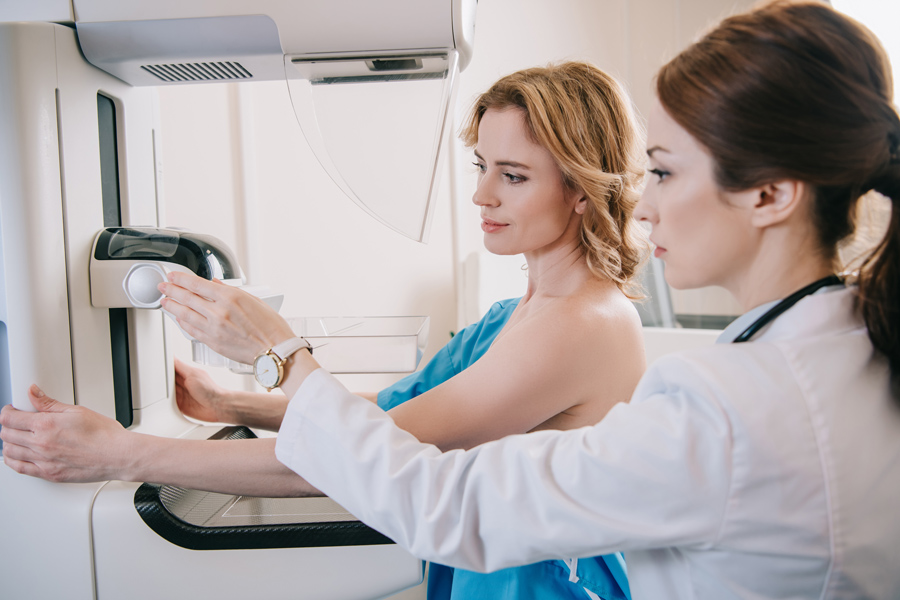Schedule an In-Office Mammogram with Your Next Visit

Early detection is key to beating breast cancer. That’s why regular screening mammograms should be part of your health plan, especially if you’re 40 or older. Thankfully, it’s easier than ever with 3-D mammograms now available for our patients in the comfort of our McKinney and Prosper offices.
Benefits of 3-D Mammography
Far from the traditional mammograms of the past, 3-D mammograms are more comfortable, more detailed, and more effective than ever before. This state-of-the-art technology provides a more than 40% increase in detection of invasive breast cancer, as well as a more than 40% reduction in false positives. That means, you’re better able to get the answers you need without missed detections or unwarranted scares.
The detailed images are comparable to those from a CT scan, providing a more detailed image that may reduce the need for follow-ups. While the radiation of a 3-D mammogram is comparable to that of a 2-D mammography machine, fewer follow-ups reduce the overall amount of radiation. It’s even been found that some 3-D mammography machines may actually use less radiation than their 2-D counterparts.
Better Mammograms for Dense Breast Tissue
About 40% of women have dense breast tissue. While dense breast tissue is normal, it does put women at a higher risk of breast cancer. According to the American Cancer Society (ACS), the relative risk of breast cancer due to high tissue density is 4-6 times the normal risk.
Pair this with a BRCA1/BRCA2 gene expression or a family history of more than one family member, and there’s a strong risk increase of breast cancer. Fortunately, a 3-D mammogram is better at detecting breast tumors in denser breast tissue.
What to Know Before Your 3-D Mammogram
- Most insurances cover a preventative screening mammogram for women 40 years and older annually. As with any other service, we always recommend contacting your insurance carrier for the specific coverage on your plan.
- The cost of a screening mammogram in our office is $225.00 due at the time of the exam.
- You can expect a screening mammogram to take about 15 minutes.
- The result is available within two weeks of the exam, as long as prior films are on file for comparison. All normal results are notified by mail. Abnormal results will be communicated by phone.
- The vaccine that prevents COVID-19 can cause swollen lymph nodes under the arm in which the shot was given. Having a mammogram soon after vaccination may cause unnecessary worry about swollen lymph nodes. For that reason, it is recommended waiting four to six weeks after your final vaccine dose before having a mammogram. That way, any lymph node swelling caused by the vaccine has time to go away.
- If you have a regular cycle, you may want to schedule your appointment in the week after an upcoming period. Your breasts should be less tender at that time.
- If you’ve had a mammogram before at another imaging center, you must arrange to transfer previous results before your appointment or bring them with you when you go to your exam. You’ll have to sign a release to get the results, which may be shared by film, CD or electronically.
- It’s a good idea to keep a record of every mammogram for future reference. Make sure to note the name and address of the center and the date you had the mammogram done.
- To get the mammogram you’ll need to undress from the waist up, so it’s a good idea to wear a shirt you can remove easily.
- Avoid using deodorants, antiperspirants, perfumes, powders or lotions on your breasts and underarm areas on the day of the exam. Ingredients in these products can show up on a mammogram and make it harder to read. (If you forget and wear one of these products, we will give you a wipe so you can remove it before the test.)
- During the exam, each breast is pressed between two plates and an X-ray image is made. Two views of each breast are taken, one from top to bottom and the other from side to side.
- Sometimes, the pressure from the plates can be uncomfortable, but it only lasts for a few seconds. If you have concerns, talk with your doctor about taking acetaminophen (eg. Tylenol) or ibuprofen (eg. Advil, Motrin) about an hour before the exam. You can also talk to the technologist before your exam if you’re worried about pain. The technologist can work with you to make you as comfortable as possible while still getting a good quality image.
Prior Mammogram Release
If you have had mammograms done in the past it is important that we obtain your prior images for comparison. Without prior images, the current radiologist may order more testing on the same area, which could result in an unnecessary diagnostic mammogram, breast biopsy and/or ultrasound.
Obtaining your prior images is easy! Simply complete the link below
Prior Mammogram Release
or download, print, and complete the form here.
For more information, or to schedule an appointment, call (972) 542-8884. You can also schedule an appointment using our easy online form.
